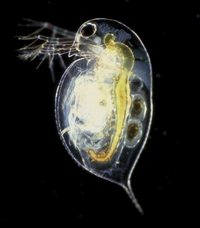
Photo from wikipedia
Bythotrephes longimanus is an invasive zooplankton predator, negatively impacting zooplankton abundance and diversity in North American lakes. Previous studies have shown that Daphnia populations in lakes move to deeper waters… Click to show full abstract
Bythotrephes longimanus is an invasive zooplankton predator, negatively impacting zooplankton abundance and diversity in North American lakes. Previous studies have shown that Daphnia populations in lakes move to deeper waters during the day, in the presence of Bythotrephes, a visual predator occupying well-lit regions. However, Daphnia vertical position can be influenced by a variety of biotic and abiotic factors. We conducted a survey to determine (1) if Daphnia daytime vertical position differed between invaded and uninvaded lakes and (2) if Daphnia vertical position in invaded lakes was affected by water chemistry variables linked to water clarity, UV exposure, and phytoplankton production, and Bythotrephes density. Invaded lakes had a lower proportion of epilimnetic Daphnia as compared to uninvaded lakes. Daphnia vertical position was species-dependent, and with a lower proportion of epilimnetic Daphnia mendotae and greater proportion of epilimnetic D. longiremis observed in invaded lakes. D. mendotae were deeper in the water column in high Bythotrephes density lakes with low dissolved organic carbon levels. Our results show Daphnia vertical position response to Bythotrephes is species specific, dependent on Bythotrephes density and influenced by local abiotic conditions, with important implications for community structure and ecosystem function in invaded lakes.
Journal Title: Hydrobiologia
Year Published: 2019
Link to full text (if available)
Share on Social Media: Sign Up to like & get
recommendations!